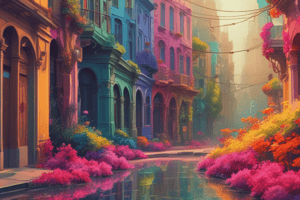Podcast
Questions and Answers
Which of the following is NOT a discrete part of color as perceived by humans?
Which of the following is NOT a discrete part of color as perceived by humans?
- Saturation
- Value (correct)
- Hue
- Brightness
In the HSV color model, which component represents the 'purity' of a color?
In the HSV color model, which component represents the 'purity' of a color?
- Intensity
- Value
- Hue
- Saturation (correct)
Which of the following is a principle of design mentioned in the text?
Which of the following is a principle of design mentioned in the text?
- Emphasis
- Rhythm
- Balance
- Unity/Variety (correct)
What is the relationship between unity and variety in a work of art?
What is the relationship between unity and variety in a work of art?
Which type of color is used in painting, where colors are mixed by applying pigments to a surface?
Which type of color is used in painting, where colors are mixed by applying pigments to a surface?
Which of the following is NOT a component of the HSV color model?
Which of the following is NOT a component of the HSV color model?
What design principle is demonstrated by the use of the infinity symbol in Rogier van der Weyden's 'Descent from the Cross'?
What design principle is demonstrated by the use of the infinity symbol in Rogier van der Weyden's 'Descent from the Cross'?
Which of the following color models describes color in terms of hue, saturation, and brightness?
Which of the following color models describes color in terms of hue, saturation, and brightness?
What is the main difference between subtractive and additive color?
What is the main difference between subtractive and additive color?
Which of the following is an example of an asymmetrical composition?
Which of the following is an example of an asymmetrical composition?
What design principle is demonstrated by the use of arrows in advertising?
What design principle is demonstrated by the use of arrows in advertising?
What are the 6 basic elements of design?
What are the 6 basic elements of design?
How does the use of color shifts within a shape imply movement in a work of art?
How does the use of color shifts within a shape imply movement in a work of art?
Which element of design deals with an infinite series of points that are arranged in a direction?
Which element of design deals with an infinite series of points that are arranged in a direction?
What is the purpose of the subtle use of the infinity symbol in Rogier van der Weyden's 'Descent from the Cross'?
What is the purpose of the subtle use of the infinity symbol in Rogier van der Weyden's 'Descent from the Cross'?
What is the term for the use of uniformly spaced intersecting lines to create the perception of value or light and dark?
What is the term for the use of uniformly spaced intersecting lines to create the perception of value or light and dark?
Which type of line is suggested by the intentional alignment of shapes?
Which type of line is suggested by the intentional alignment of shapes?
In what dimensions does Shape exist?
In what dimensions does Shape exist?
Which artist's wire sculptures and portraits exemplify the expressive power of line in three dimensions?
Which artist's wire sculptures and portraits exemplify the expressive power of line in three dimensions?
Study Notes
Color Models and Principles
- HSV color model describes color in terms of hue, saturation, and brightness
- Saturation represents the 'purity' of a color in the HSV color model
- Brightness is a component of the HSV color model
Design Principles
- Unity and variety in a work of art are related, with unity providing a sense of oneness and variety providing a sense of diversity
- The principle of balance is demonstrated by the use of the infinity symbol in Rogier van der Weyden's 'Descent from the Cross'
- The principle of direction is demonstrated by the use of arrows in advertising
- The 6 basic elements of design are: line, shape, form, value, color, and texture
Color Theory
- Subtractive color is used in painting, where colors are mixed by applying pigments to a surface
- The main difference between subtractive and additive color is how the colors are mixed and perceived by the human eye
- Color shifts within a shape can imply movement in a work of art
Elements of Design
- Line is an element of design that deals with an infinite series of points arranged in a direction
- Shape exists in two dimensions
- Form exists in three dimensions
- Hatching is the term for the use of uniformly spaced intersecting lines to create the perception of value or light and dark
- Alignment of shapes can suggest a type of line
Artists and Styles
- Rogier van der Weyden's 'Descent from the Cross' is an example of a work of art that uses the infinity symbol to create a sense of balance
- Alexander Calder's wire sculptures and portraits exemplify the expressive power of line in three dimensions
Studying That Suits You
Use AI to generate personalized quizzes and flashcards to suit your learning preferences.
Description
Learn about the most prominent element of design in art - color. Explore how color is perceived by humans and the three main components - hue, saturation, and brightness. Understand how the wavelength of a color determines its position on the spectrum.




